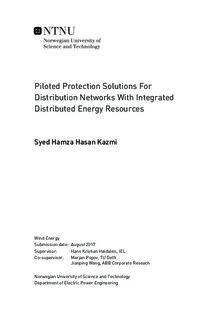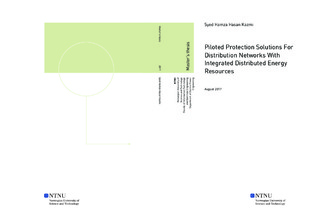| dc.description.abstract | The wide scale integration of distributed energy resources (DERs) in the distribution networks (LV/MV) over the last few decades has resulted in new challenges for the protection system. This thesis work explores the possibility to overcome challenges associated with overcurrent protection schemes, which are conventionally employed for distribution networks, by utilizing communication-based protection techniques, which are widely used in protection of HV transmission network. These techniques include piloted directional protection techniques based on conventional methods and transient signals. Moreover, current-based line differential protection is also investigated.
The individual algorithms for all these protection schemes used by relay manufacturers (including ABB, Siemens, and SEL) are developed and tested. The test network, system parameters and performance criteria are developed in the PSCAD/EMTDC environment, whereas the individual algorithms are developed in MATLAB/Simulink. The system and performance parameters are carefully designed to reciprocate the performance of the modern distribution networks with weak sources replicating the performance of DERs during faults. Up to this point, the fault clearing time has not been critical for these networks but the integration of DERs has resulted in the additional requirement to fulfill the critical clearing time of each generator, therefore relay operating time is also considered in this study. However, the impacts of some real world imperfections including harmonics, measurement inaccuracies, communication noise and data loss etc. are ignored.
Different relay manufacturers propose using sequence components for different fault types. A directional algorithm combining the principles of all the conventional techniques based on different symmetrical components has been developed and tested. This algorithm responds to both the balanced and unbalanced faults while overcoming the limitations of each individual technique. The test cases incorporate the weak network conditions in order to see the dependability of the protection functions.
The operating principles of investigated transient-based directional algorithms are fundamentally different. Therefore, each method is extensively tested and the results are compared. These techniques, also called ultra-high-speed directional methods, claim to fulfill the minimum operating time requirements without compromising the security or dependability of operation. Moreover, some less-explored but highly effective algorithms are also tested, which would be ideal in this case including current-only transient-based directional algorithms.
Line differential schemes based on dual slope current or charge comparison techniques are vulnerable to capacitive currents and saturation of CTs but their performance is ideal for weak networks, due to its selectivity as a unit protection. These schemes are included in the study to compare the performance with directional-based pilot protection schemes. The assessment is performed in both the current plane (operating and restraint current) and the polar plane for comparison.
Each of the tested algorithms has some inherent shortcomings. The ultimate goal is to identify these restrictions and suggest methods either to overcome them or to make relevant modifications. The communication-based limitations are investigated for each of the tested algorithms to assess the practicality of application, while the economic impacts of additional hardware to determine fault direction in the distribution network are also considered.
The above substantial assessment of all the piloted protection schemes to determine their feasibility for the protection of modern distribution networks has not been performed previously, which puts a rather unique perspective to this study. | |

